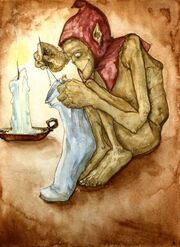No edit summary |
No edit summary |
||
| Line 4: | Line 4: | ||
In folklore, a brownie is a type of hob, similiar to a hobgoblin. Brownies are said to inhabit houses and aid in tasks around the house. However, they do not like to be seen and only work at night, traditionally in exchange for small gifts or food. Among food, they especially enjoy porridge and honey. They usually abandon the house if their are called payments, or if the owners of the house misuse them. Brownies make their homes in an unused part of the [[File:Brownies1.jpg|thumb|left|248px|Little brownies]]house. |
In folklore, a brownie is a type of hob, similiar to a hobgoblin. Brownies are said to inhabit houses and aid in tasks around the house. However, they do not like to be seen and only work at night, traditionally in exchange for small gifts or food. Among food, they especially enjoy porridge and honey. They usually abandon the house if their are called payments, or if the owners of the house misuse them. Brownies make their homes in an unused part of the [[File:Brownies1.jpg|thumb|left|248px|Little brownies]]house. |
||
| − | Folklorist John Gregorson Campbell distinguishes between the English brownie, which lived in houses, and the Scottish ''uruisg'' or'' urisk'', which lived outside in streams and waterfalls and was less likely to offer domestic help. The ''uruisg'' enjoyed solitued at certain seasons of the year. At the end of the harvest, he became more sociable, and hovered |
+ | Folklorist John Gregorson Campbell distinguishes between the English brownie, which lived in houses, and the Scottish ''uruisg'' or'' urisk'', which lived outside in streams and waterfalls and was less likely to offer domestic help. The ''uruisg'' enjoyed solitued at certain seasons of the year. At the end of the harvest, he became more sociable, and hovered around farmyards, stables and cattlehouses. He particularly enjoyed dairy products and tended to intrude on milkmaids, who made regularlibations of milk or cream to charm him off, or to gain his favour. He was usually seen only by those who possessed second sight, though there were instances when he made himself visible to ordinary people as well. He is said to have been jolly and personable, with flowing yellow hair, wearing a broad blue bonnet and carrying a long walking staff. |
[[Category:Mythological creatures]] |
[[Category:Mythological creatures]] |
||
[[Category:Folklore]] |
[[Category:Folklore]] |
||
Revision as of 06:46, 14 July 2011
A brownie/brounie or urisk (Lowland Scots) or brunaidh, uruisg or gruagach (Scottish Gaelic) is a legendary

A brownie
creature popular in folklore around Scotland and England (especially the north, though commonly hobs have this role). It is the Scottish and Northern English counterpart of the Scandinavian tomte, the Slavic domovi and the German Heinzelmannchen
Tradition:
In folklore, a brownie is a type of hob, similiar to a hobgoblin. Brownies are said to inhabit houses and aid in tasks around the house. However, they do not like to be seen and only work at night, traditionally in exchange for small gifts or food. Among food, they especially enjoy porridge and honey. They usually abandon the house if their are called payments, or if the owners of the house misuse them. Brownies make their homes in an unused part of the

Little brownies
house.
Folklorist John Gregorson Campbell distinguishes between the English brownie, which lived in houses, and the Scottish uruisg or urisk, which lived outside in streams and waterfalls and was less likely to offer domestic help. The uruisg enjoyed solitued at certain seasons of the year. At the end of the harvest, he became more sociable, and hovered around farmyards, stables and cattlehouses. He particularly enjoyed dairy products and tended to intrude on milkmaids, who made regularlibations of milk or cream to charm him off, or to gain his favour. He was usually seen only by those who possessed second sight, though there were instances when he made himself visible to ordinary people as well. He is said to have been jolly and personable, with flowing yellow hair, wearing a broad blue bonnet and carrying a long walking staff.